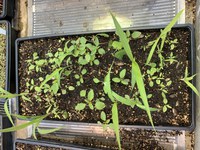Drought May Facilitate Spread of Noxious Weeds
(Click the image below to view a high-resolution image that can be downloaded)
Producers need to be vigilant about preventing the spread of noxious weeds, North Dakota State University Extension specialists and researchers say.
Due to extreme drought conditions across much of North Dakota, ranchers are purchasing hay and feed to supplement existing feed resources and delay grazing.
“Transported hay and feed are one of the primary methods of dispersal and introduction for noxious weeds,” says Miranda Meehan, NDSU Extension livestock stewardship specialist and Extension disaster education coordinator.
Here are some things to keep in mind when purchasing and feeding hay:
- Purchase certified weed-free hay if possible.
- Feed hay in an area where weeds can be managed easily, such as a dry lot or tame grassland.
- Do not feed hay on rangeland where weeds are more difficult to control and herbicide may impact desirable plant species negatively.
Common noxious weeds transported in hay include thistles, leafy spurge, absinth wormwood, knapweeds and houndstongue. Hay and other feed also can carry very aggressive weeds such as Palmer amaranth.
Grain Screenings a Weed Carrier
“Grain screenings are usually a price-competitive source of cattle feed, especially during a drought when forage supplies may be short, but they might contain things that you don’t want on your farm at any price, such as Palmer amaranth,” warns Karl Hoppe, Extension livestock systems specialist at the NDSU Carrington Research Extension Center.
Grain screenings consist of cracked or small pieces of grain plus foreign matter. The foreign matter can be other kinds of grain, sticks, leaves, insects, rodent feces, fungal bodies such as ergot and sclerotia, and weed seeds.
Grain screenings can carry viable weed seeds that geminate in unusual locations.
“Where the screenings are unloaded can lead to the start of a weed infestation,” Hoppe says. “These areas proliferate in feed yards that do not have fastidious weed control.”
Brian Jenks, weed scientist at the NDSU North Central Research Extension Center, says: “While Palmer amaranth looks like a pigweed, it is resistant to many of our commonly used herbicide modes of action, it is extremely prolific in its seed production and it can spread like wildfire. The best way to control Palmer amaranth is not having it enter your farm.”
Palmer Amaranth Control
NDSU Extension specialists have several tips on how to manage feed and manure that may be contaminated with Palmer amaranth seed:
- Buy cleaned grain. However, purchased feed isn’t routinely tested for weed seeds.
- Have screenings tested to determine the presence of Palmer amaranth prior to feeding. Feeding whole seeds may perpetuate the problem. Some seeds, especially tiny, hard-shelled seeds from Palmer amaranth, can escape digestion by cattle. The Palmer amaranth seed is black and shiny but cannot be distinguished visually from other pigweed seed. The National Agricultural Genotyping Center in Fargo can conduct a DNA test to determine if the pigweed seed is Palmer amaranth.
- Grind the screenings so fine that the seeds are destroyed. For a small-seeded plant such as Palmer amaranth, aggressive grain processing is needed, and hammer milling usually is the best option.
- Compost manure to reduce seed viability.
- If spreading fresh manure, keep records of where it is spread so the field can be monitored for weed infestation throughout the growing season.
- Clean manure-spreading equipment before moving to a new field, especially if you are doing custom work for someone. Clean the spreader with an air hose for dry manure or a pressure washer for wet manure. Make sure to record where cleanout occurs so you can monitor that spot for weed growth during the growing season.
- Spread weed seed-heavy manure on tame grass pastures or grass hayfields because more options are available for herbicide control on them. Never spread manure on native rangeland. Adding nutrients can benefit invasive grass species such as Kentucky bluegrass and smooth brome.
Composting Manure an Option
“Composting manure should destroy weed seed viability; however, management practices will determine success,” says Mary Keena, Extension livestock environmental management specialist at the NSDU Carrington Research Extension Center.
“Making sure the moisture of the compost pile is maintained at 50% and the pile reaches temperatures of 140 to 160 degrees Fahrenheit throughout the composting process is critical,” she says.
A guide to the process and management of animal manure compost is available at https://tinyurl.com/AnimalManureComposting.
But if just one seed survives being eaten by cattle and escapes the heat in composting, then is spread onto a crop field, that one Palmer amaranth plant can make up to a million seeds in a year.
“Even in direct competition with a crop, some plants can still produce up to 100,000 seeds in a year,” cautions Joe Ikley, NDSU Extension weed specialist. “Due to this extensive seed production, the ability of the weeds to germinate throughout the growing season, and widespread resistance to glyphosate and Group 2 herbicides, herbicide programs for control of severe infestations of waterhemp and Palmer amaranth often will cost two to three times the amount of money spent on a weed control program in fields without these two weeds.”
He urges producers to be aware of the noxious weeds that may be present when purchasing hay and feed, and if necessary, to purchase hay and feed from another location. Producers also should consider possible liability issues of not controlling noxious weeds.
For more information on identifying and controlling noxious weeds, contact your local Extension agent or visit NDSU Extension’s website at https://www.ag.ndsu.edu/weeds. For additional information on liability issues, go to https://www.nd.gov/ndda/news/use-screenings-feed-requires-monitoring or https://www.nd.gov/ndda/plant-industries/noxious-weeds.
NDSU Agriculture Communication - May 13, 2021
Source: Karl Hoppe, 701-652-2951, karl.hoppe@ndsu.edu
Source: Joe Ikley, 701-231-8157, joseph.ikley@ndsu.edu
Source: Brian Jenks, 701-857-7677, brian.jenks@ndsu.edu
Source: Mary Keena, 701-652-2951, mary.keena@ndsu.edu
Source: Miranda Meehan, 701-231-7683, miranda.meehan@ndsu.edu
Editor: Ellen Crawford, 701-231-5391, ellen.crawford@ndsu.edu


